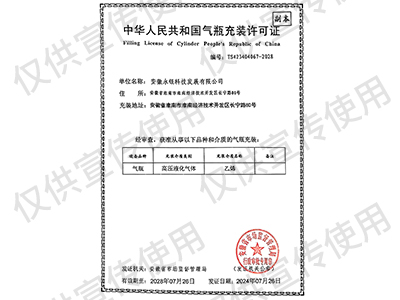Organic gas
![]()
Chemical formula:C4h8
CAS number:115-11-7
Purity:99.9% to 99.999%
Technical indicators
|
Isotenepurity≥99.7% |
|
|
Impurity content(ppm) |
Purity index (%) |
|
Methoxylate(C2H6O) |
≤200 |
|
Methanol(CH4O) |
≤50 |
|
Other carbon four(Other C4) |
≤500 |
|
T-butanol(C4H10O) |
≤50 |
|
Methyl tert-butyl ether(C5H12O) |
≤50 |
|
Oligomers(Oligomeric) |
≤50 |
|
water(H2O) |
≤100 |
Packaging specifications
|
PackageSpecification |
PackageSpecification |
|
2LSteel cylinder |
118LSteel cylinder |
|
4LSteel cylinder |
400LSteel cylinder |
|
8LSteel cylinder |
800LSteel cylinder |
|
40LSteel cylinder |
926LSteel cylinder |
|
47LSteel cylinder |
24m³ISO tank |
|
50LSteel cylinder |
58m³Tank truck |
|
……Customized on demandPackaging specifications |
|
1. Basic physical and chemical properties
|
index |
Parameter value |
Remark |
|
Molecular Formula |
C4H8 |
Structural formula:(CH₃)₂CCH₂ |
|
Appearance |
Colorless gas (Current temperature and pressure) |
Has an unpleasant odor, flammable |
|
Boiling point |
-6.9℃ |
|
|
Flash point |
-77℃ |
Flammable and explosive characteristics are significant |
|
density(25℃) |
0.5879 g/cm³ |
|
2. Source of isobutene
The sources of isobutene are mainly divided into two technical routes: refining and chemical by-product extraction and chemical synthesis. The specific source classification and process characteristics are as follows:
1、Mainstream source: Petrochemical/ Refinery by-products (accounting for more than 90% of global production capacity)
By-product C₄ Distillate of Catalytic Cracking Device
Content: Isobutylene accounts for about 5%-12%, and is present in liquefied petroleum gas (LPG).
Process: Extract isobutene by fractionation, solvent extraction or adsorption separation (such as molecular sieve).
Steam cracking device by-product C₄ distillate
Content: isobutene accounts for 20%-30% (higher than refinery gas), accompanied by n-butene, butadiene, etc.
Separation Process: First remove butadiene, and the remaining C₄ components are separated by sulfuric acid extraction or etherification.
2、Synthesis process route (production of high purity isobutylene)
MTBE cracking method (domestic leading process, accounting for >70%)
Principle: Methyl tert-butyl ether (MTBE) is cleaved under the action of a catalyst to form isobutene and methanol.
Advantages: The product purity is ≥99.5% (up to 99.99%), no corrosion and low pollution.
Technology branch:
Low pressure method: reaction temperature150-180℃, pressure 0.3-0.5MPa.
High-voltage method: lower energy consumption, which is the direction of industry upgrading.
Tert-butanol (TBA) dehydration method
Reaction: tert-butanol in acidic catalysts (e.g.Y-Alumina) dehydrate to form isobutene.
Features: Suitable for low-concentration TBA aqueous solutions (catalytic distillation process can improve efficiency).
Isobutane dehydrogenation
Process: Isobutane is dehydrogenated under the action of chromium-aluminum catalyst (500-600℃) to produce isobutene and hydrogen.
Application: Coupled with MTBE synthesis process (isobutene is used for etherification reaction).
n-butene framework isomerization
Technology: YZ type molecular sieve catalyst converts n-butene into isobutene, with a one-way conversion rate of ≥40%.
Significance: Solve the problem of insufficient isobutene resources in mixed C₄.
3、Other sources
Oilfield gas/natural gas byproduct C₄: Contains only alkanes (isobutane) and has no olefin components.
Co-oxidation method co-production: When propylene and isobutane are co-oxidized to produce propylene oxide, isobutene is produced by-product.
Note: Raw material selection directly affects economics——The cost of refining and chemical by-products is low but the purity is limited (deep separation is required), the synthesis process has higher purity but greater investment; in 2025, domestic MTBE overcapacity accelerates the transformation to isobutene.
3. Main uses
As a key petrochemical basic raw material, isobutene has a wide range of uses covering three major fields: polymer materials, fuel additives and fine chemicals. The specific application classification is as follows:
1. Polymer synthesis (core application)
Butyl rubber production
Copolymerized with isoprene to produce butyl rubber, which has excellent air tightness (the air transmittance is more than 8 times lower than that of natural rubber), and is used in tire inner tubes, medical seals, etc.
Polyisobutylene (PIB) series products
Low molecular weight PIB (molecular weight 350-3500): lubricating oil additives, chewing gum bases, adhesive bases;
Medium-high molecular weight PIB (molecular weight 10,000-1 million): sealant, cable insulation material, rubber modifier.
2. Fuel and oil additives
Methyl tert-butyl ether (MTBE)
Reacting with methanol to produce MTBE, increasing the octane number and explosion resistance of gasoline, accounting for more than 50% of isobutene consumption.
Clean fuel components
Isobutene oligomerizes isooctane (C12H26), used to prepare low-sulfur and low-vapor pressure cleaning gasoline.
3. Fine chemical synthesis
|
Application Area |
Representative products |
Function |
|
Medical Intermediate |
Drugs such as Rifampin and Tyrannosol |
Antibacterial and antiasthma treatment |
|
pesticide |
Insecticide acaricides such as tertexophen and pyrimidine |
Crop protection |
|
Antioxidants |
T-butylphenol antioxidants (e.g.BHT) |
Anti-aging of plastics and rubber |
|
Fragrances and solvents |
Trimethylacetate fragrances, coating solvents |
Daily chemical product additives |
4、Other industrial applications
Sealing Materials:Polyisobutylene-based sealant is used for building waterproofing and automotive sealing;
Electrical Insulation Materials:High molecular weightPIB is used for cable insulation;
Alkylated gasoline:React with isobutane to produce high octane gasoline components.
- Previous:n-butene
- Next:Ethylene oxide





